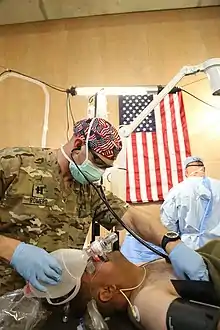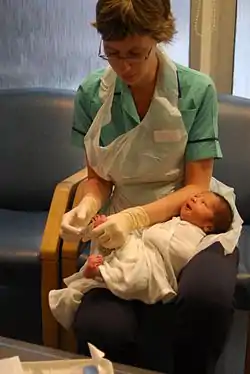Nurse anesthetist
A nurse anesthetist is an advanced practice nurse who administers anesthesia for surgery or other medical procedures. They are involved in the administration of anesthesia in a majority of countries, with varying levels of autonomy.
 A United States Army nurse anesthetist providing independent anesthesia on a forward surgical team | |
| Occupation | |
|---|---|
Activity sectors | Anesthesia, nursing |
| Description | |
| Competencies | Administration of anesthetics and the elimination of pain |
Education required | Varies by country |
Fields of employment |
|
A survey published in 1996 reported that there were 107 countries where nurses administer anesthesia in some form, and a further nine countries where nurses act as assistants in the administration of anesthesia.[1] Depending on the country or locality, their role may be limited to intraoperative care during anesthesia itself or may also extend before and after (for preanesthetic assessment and immediate postoperative management).[2] In some countries and localities, nurse anesthetists provide anesthesia to patients independently; in others they do so under the supervision of anesthesiologists.[2]
The International Federation of Nurse Anesthetists was established in 1989 as a forum for developing standards of education, practice, and a code of ethics.[3]
United States
In the United States, nurse anesthetists have the protected title of Certified Registered Nurse Anesthetist (CRNA); they account for approximately half of the anesthesia providers in the United States and are the main providers of anesthesia in rural America.[4]
Nurses have been providing anesthesia care to patients since the American Civil War.[5] Nurse anesthetists are considered an essential role to the health care workforce. They provide pain management and emergency services to the air way management, which was very important to patients in the Civil War.[6]
The National Association of Nurse Anesthetists professional association was established by Agatha Hodgkins in 1931.[7] Depending on the local system of healthcare, they participate only during the operation itself or may also be involved before and after (for preanesthetic assessment and immediate postoperative management). It was renamed the American Association of Nurse Anesthetists in 1939.[7] The group established educational institutions for nurse anesthetists in 1952 and established the CRNA certification in 1957.[7] AANA continuing education was established in 1977.[7] As of 2011, some 92% of CRNAs in the U.S. were represented by the AANA.[7]
Scope of practice rules vary between healthcare facility and state. Before 2001, Medicare required that physicians supervise CRNAs in the administration of anesthesia.[7] In 2001, Medicare's rules changed, allowing individual states to decide whether CRNAs may administer anesthesia without physician supervision.[7] In the absence of a state requirement that anesthesiologists supervise CRNAs, individual healthcare facilities decide.[7] CRNA organizations have lobbied in many states for the ability to practice without anesthesiologist supervision; these efforts are opposed by physician groups.[7] In 2011, sixteen states granted CRNAs autonomy, allowing them to practice without anesthesiologist oversight.[7] In 2017, there were 27 states in which CRNAs could independently practice (that is, "without a written collaborative agreement, supervision or conditions for practice").[8] In 2020, there was no physician supervision requirement for nurse anesthetists in ambulatory surgical facilities in 31 states[9] In states that have opted out of supervision, the Joint Commission and CMS recognize CRNAs as licensed independent practitioners.[10] In states requiring supervision, CRNAs have liability separate from supervising practitioners and are able to administer anesthesia independently of anesthesiologists.[11][12][13][14]
See also
References
- McAuliffe, M. S; Henry, B (1996). "Countries where anesthesia is administered by nurses". AANA Journal. 64 (5): 469–79. PMID 9124030.
- McAuliffe, M. S; Henry, B (1998). "Survey of nurse anesthesia practice, education, and regulation in 96 countries". AANA Journal. 66 (3): 273–86. PMID 9830854.
- International Federation of Nurse Anesthetists (2007). About IFNA... Retrieved May 23, 2007, from http://ifna-int.org/ifna/page.php?16
- Daughettry, Lindsay (2010). "Is There a Shortage of Anesthesia Providers in the United States?". RAND Health. Retrieved September 30, 2018.
- "CRA Fact Sheet".
- "What is a Nurse Anesthetist?". www.kumc.edu. Retrieved March 29, 2022.
- Matsusaki T, Sakai T (2011). "The role of certified registered nurse anesthetists in the United States". Journal of Anesthesia. 25 (5): 734–740. doi:10.1007/s00540-011-1193-5. PMID 21717163. S2CID 7991965.
- Laura Dyrda, 27 states where CRNAs can practice independently, Becker's ASC Review (January 18, 2017).
- Angie Stewart, 31 states with no CRNA supervision requirement in ASCs, Becker's ASC Review (October 14, 2020).
- "Archived copy" (PDF). Archived from the original (PDF) on August 4, 2018. Retrieved August 3, 2018.
{{cite web}}: CS1 maint: archived copy as title (link) - Joint Commission on Accreditation of Healthcare Organizations. "Standards Revisions Related to the Centers for Medicare & Medicaid Services (CMS)" (PDF). Archived from the original (PDF) on August 4, 2018. Retrieved August 3, 2018.
- Gene Blumenreich. "A Surgeons Responsibility for CRNAs" (PDF). www.aana.com. Archived from the original (PDF) on August 4, 2018. Retrieved August 3, 2018.
- American Association of Nurse Anesthetists (2013). "Scope of Nurse Anesthesia Practice" (PDF). www.aana.com. Archived from the original (PDF) on August 4, 2018. Retrieved August 3, 2018.
- Gene Blumenreich. "Legal Briefs: Captain of the Ship Doctrine" (PDF). www.aana.com. Retrieved August 3, 2018.

